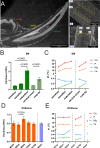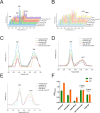This is a preprint.
Multi-modal characterization of rodent tooth development
- PMID: 39554162
- PMCID: PMC11565992
- DOI: 10.1101/2024.11.01.621612
Multi-modal characterization of rodent tooth development
Abstract
Craniofacial tissues undergo hard tissue development through mineralization and changes in physicochemical properties. This study investigates the mechanical and chemical properties of developing enamel, dentin, and bone in the mouse mandible. We employ a multi-modal, multi-scale analysis of the developing incisor and first molar at postnatal day 12 by integrating micro-computed tomography (microCT), nanoindentation (NI), energy dispersive spectroscopy (EDS), and Raman spectroscopy. Our findings demonstrate distinct patterns of mechanical, elemental, and chemical changes across mineralized tissues. These results suggest that mineral composition drives mechanical properties across different craniofacial hard tissues. Integrating multi-modal characterization of mineralized tissues opens new opportunities for investigating structure-function relationships in craniofacial biology and genetics.
Keywords: dental development; materials characterization; mineralized tissues; multi-modal.
Conflict of interest statement
Competing Interest Statement: No competing interests to disclose. No competing interests to disclose.
Figures





Similar articles
-
Multimodal Characterization of Rodent Dental Development.ACS Appl Mater Interfaces. 2025 Jun 11;17(23):33745-33755. doi: 10.1021/acsami.5c08408. Epub 2025 May 28. ACS Appl Mater Interfaces. 2025. PMID: 40436377
-
Investigating simultaneous mineralization across layers during tooth development using atomic force microscopy and Raman spectroscopy.J Mech Behav Biomed Mater. 2025 Oct;170:107094. doi: 10.1016/j.jmbbm.2025.107094. Epub 2025 Jun 4. J Mech Behav Biomed Mater. 2025. PMID: 40513433
-
The effect of therapeutic radiation on dental enamel and dentin: A systematic review.Dent Mater. 2022 Jul;38(7):e181-e201. doi: 10.1016/j.dental.2022.04.014. Epub 2022 May 12. Dent Mater. 2022. PMID: 35570008
-
Craniofacial Bones and Teeth in Spacefarers: Systematic Review and Meta-analysis.JDR Clin Trans Res. 2023 Apr;8(2):113-122. doi: 10.1177/23800844221084985. Epub 2022 Mar 20. JDR Clin Trans Res. 2023. PMID: 35311413 Free PMC article.
-
The relationship between enamel and dentin calibrated-radiographic-density measured by cone beam computed tomography and dental caries status in young adults.BMC Oral Health. 2025 May 26;25(1):796. doi: 10.1186/s12903-025-06146-4. BMC Oral Health. 2025. PMID: 40420104 Free PMC article.
References
-
- Cuny G, Guinot G, & Enault S (2017) Mineralized Tissues. Evolution of Dental Tissues and Paleobiology in Selachians), pp 1–18.
-
- Giacaman RA, Perez VA, & Carrera CA (2016) Mineralization processes in hard tissues. Biomineralization and Biomaterials), pp 147–185.
-
- Hu JC & Simmer JP (2007) Developmental biology and genetics of dental malformations. Orthod Craniofac Res 10(2):45–52. - PubMed
Publication types
Grants and funding
LinkOut - more resources
Full Text Sources
